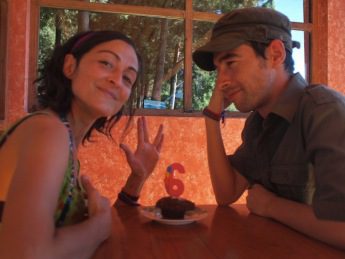A Day at the Market
Mexican food is a treat for the eyes and stomach. From pre-Hispanic cuisine in San Andrés Cholula to colorful street food in Oaxaca, we have had nothing but good experiences, even if we have long shed our omnivorous skins.
Full disclosure: we abstain from meat, but indulge in occasional chapulines (spicy grasshoppers) and fish. Basically, we don’t eat anything with 4 legs or less. Although Mexicans are generally keen on meat, and seem particularly infatuated with chicken, it’s not difficult to sidestep this minor encumbrance. Most dishes can be easily modified in order to accommodate a vegetarian sensibility; if not, there are plenty of alternatives out there – and they’re usually delicious.
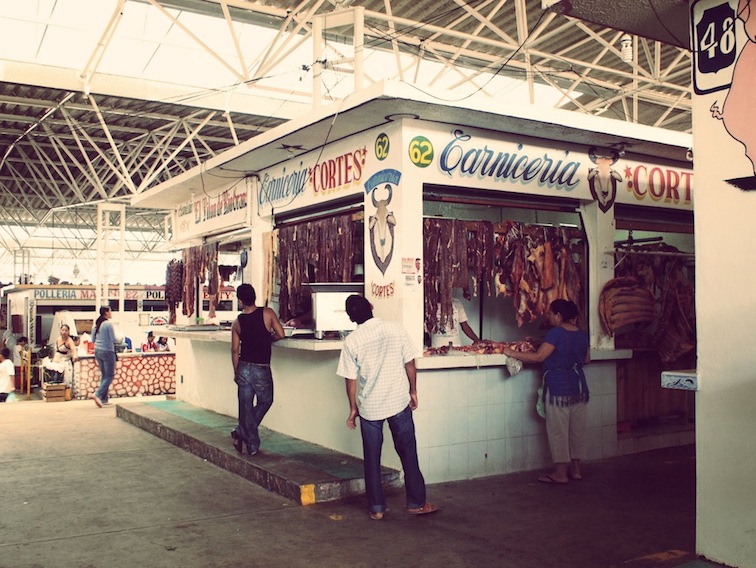
Mexican meat
A quesadilla, eaten in a random street close to nowhere in particular, will definitely be cheap, filling and in all likelihood scrumptious. Why? Obviously, one reason is that locals have been cooking them for centuries and are very good at it; another reason is fresh ingredients.
Having left the European countryside in favor of capital cities (it’s where the money is; not in trees, alas), we had become accustomed to a dread of quality fruit and vegetables. By accustomed I evidently mean “nagging about it all the time”. In order to taste an actual tomato, one who wasn’t a red ball of mushy disappointment disguised as a tomato, we had to either shell out a lot of euros or go to Sardinia. Usually, we couldn’t afford either, so were stuck with sad, tasteless pap.
In Mexico, it’s a pleasure to visit the markets and see the various people selling their wares on any given day of the week. Although certainly places to conduct serious business, they also display a panoply of cultures, colors and smells.

You say tomatoes
Our first real taste of life inside a busy market was in Oaxaca. The Benito Juárez is centrally located, and brimming with all the components of traditional Oaxacan gastronomy, from “mole” to mezcal. A few kilometers away lies the Sunday market in Tlacolula, which has a more indigenous flavor, as evidenced by the sight of people bartering and old ladies mixing the ancient drink of “tejate”, prepared with corn, cacao, cacao flower and seeds of the mamey fruit.
That a big part of an immersion into a foreign culture is done through our taste buds is nothing new. As Jean Anthelme Brillat-Savarin famously noted: “Tell me what you eat, and I will tell you what you are.” If such a sentiment still holds true today is mainly due to the ebullient presence of markets like the ones above, where dairy, poultry, produce and fruit vie for the customer’s attention while reflecting the local culture and economy.
As a small and imperfect glimpse into a farmer’s market in Mexico, we’ve collated a few smiling faces accompanying the products and services they offer every day at the Benito Juárez indoor market in Puerto Escondido. Yes, Benito Juárez seems to be a popular name for markets.
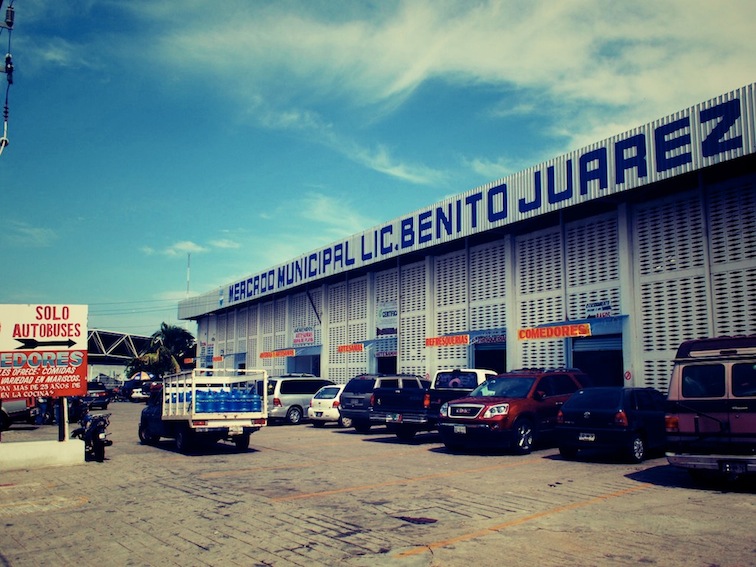
Benito Juárez Market in Puerto Escondido
As previously mentioned in our Insolvency Update of July, we decided to stay in Puerto Escondido for a whole month, doing mostly nothing by the sea and seeing if we could bring our costs down. Visiting the local market on a regular basis was one of our priorities, so what follows is an account of our customary route, as we swing and swerve between gawking fish and headless meat, careful not to spend our monthly allowance in one go.
Most of the market’s outlying corners are dedicated to garments and other diverse paraphernalia, from sandals to backpacks or umbrellas. They’re usually not very busy, and still seem a bit out of place to our eyes. Nonetheless, they are part of the show, which explains why we still go through them nearly every time we visit.
The market is divided into distinct sections, each catering to a specific range of products. The exception seems to be produce and fruit, which are ubiquitous – either within the confines of a proper stand or scattered in small mounds of organic goodness.
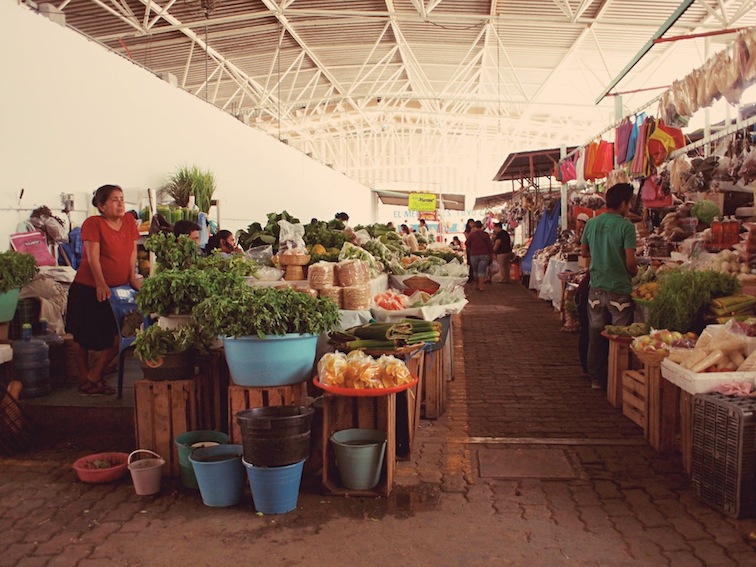
Selling wares at Benito Juárez Market
We begin our little journey by approaching a local vendor, whose wares can be found in small heaps on the floor. His selection is comprised of various fruit and vegetables, all fresh and ready to take home. We notice, amongst others, potatoes, red peppers, tomatoes, black beans, pomegranates, chayotes (similar to cucumber in taste) and bread. We buy apples, still ripening, and “criollo” avocados, which is the native undomesticated variety from which the hybrids we normally see have been created.
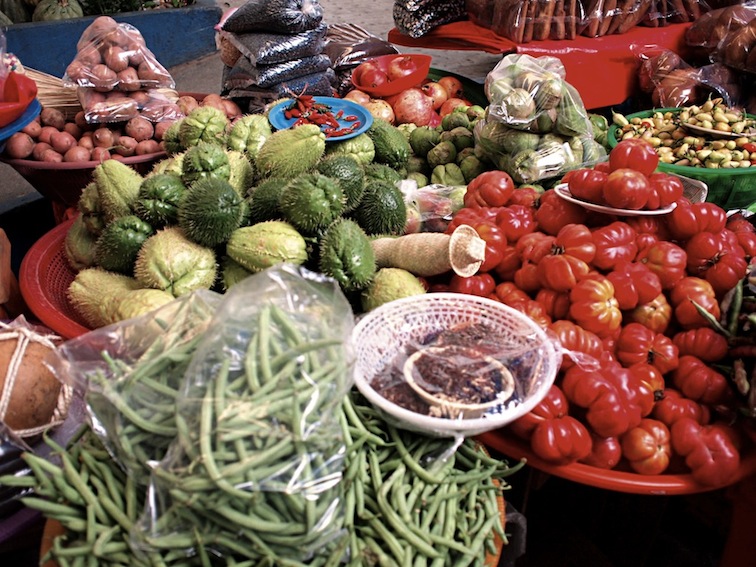
Beans, chayotes, tomatos, red peppers, chapulines, etc…
We then proceed to the fishmongers’ area, where several types of fish and shrimp lie in the cold, as their tenders swat insects away. This time, we opt for smoked fish, settling on a large piece of Barrilete Negro (aka Black Skipjack). There are plenty of other varieties available, either smoked, fried or salted.
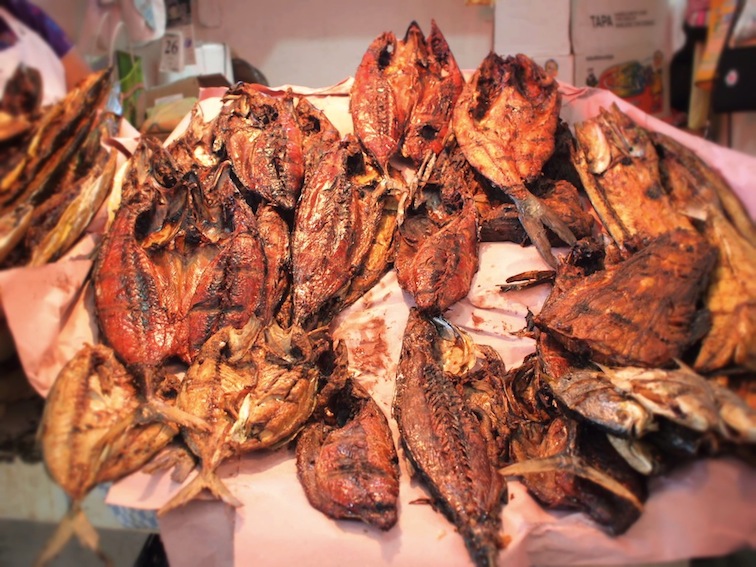
Smoked and fried fish
A trip to the market would be incomplete without a mainstay of Oaxacan cuisine, so we head out to find some chocolate. Usually standing next to “mole” and coffee, chocolate is normally sold in small cubes or rectangles. We choose a personal favorite, which is mixed with coffee and thin slices of coconut. We pick a small bag containing five easy pieces, in memory of Karen Black. We also get a batch of round totopos, or “thunder tortillas” according to their Nahuatl etymological root (they’re crunchy).
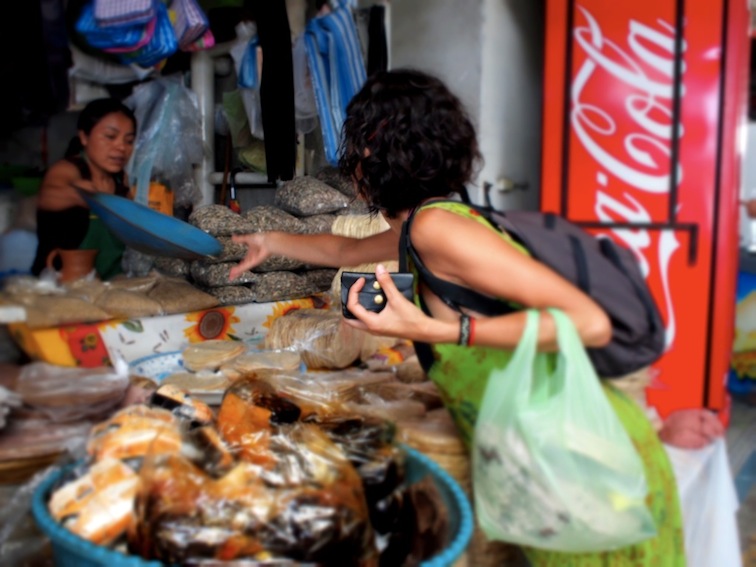
Buying chocolate and totopos
Our next stop is the dairy section, or, more specifically, a booth where a smiling lady sells quesillo, the typical Oaxacan stringy cheese. We have become loyal customers, and often get free tastings of other cheeses on display. How we will ever survive without quesillo is at the moment beyond me…
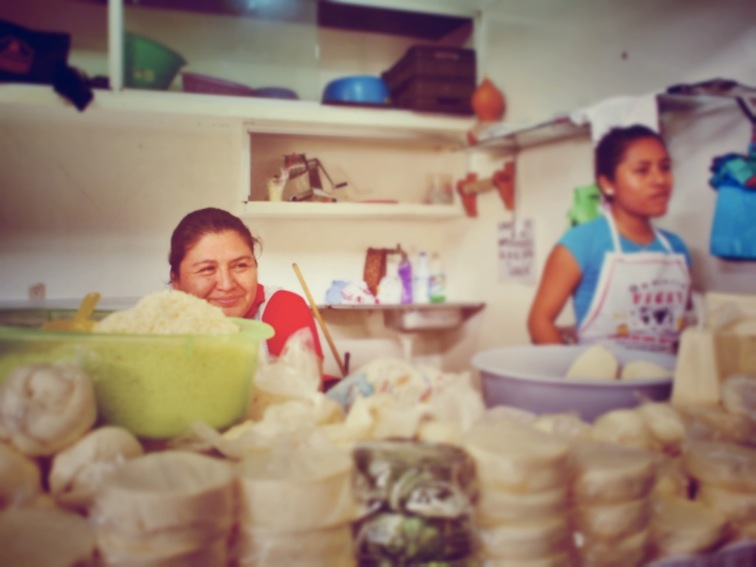
Blessed are the cheese makers
Close by we snatch up a loaf of egg bread with sesame seeds, which goes splendidly with avocado and quesillo – or anything, really… Before we proceed with our shopping extravaganza, we take a break at Refresqueria Maria Sabina to enjoy a couple of cold beverages. They have several juices on offer, flavors including Horchata, Piñacolada, Orange, Jamaica (hibiscus, a common staple in Oaxaca) and – my regular choice – Chilacayote (fig-leaf gourd). It replenishes the soul, at 5 MXN (0.30 EUR) per small cup.
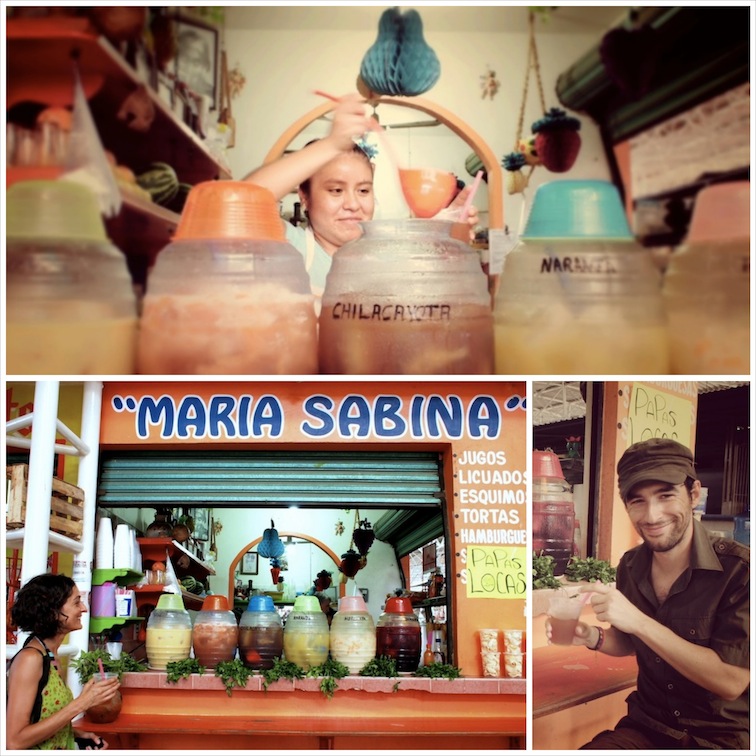
At Maria Sabina, enjoying Chilacayote juice
The Benito Juárez also boasts a few mini-markets, where we take the opportunity to buy a pack of Palmeras cookies. Not really traditional, but we’re members of the cookie monster family. Ambling through flowers and butchers, we renew our search of delectable ingredients for our salads. First, we buy carambolas (aka starfruit) and nopales (prickly pear cactus pads), both discoveries we made while in Mexico. Next on the list are papayas. Supply is not exactly meager, so we spend a bit of time going through a few vendors, trying to find “the one” (we take papayas very seriously).
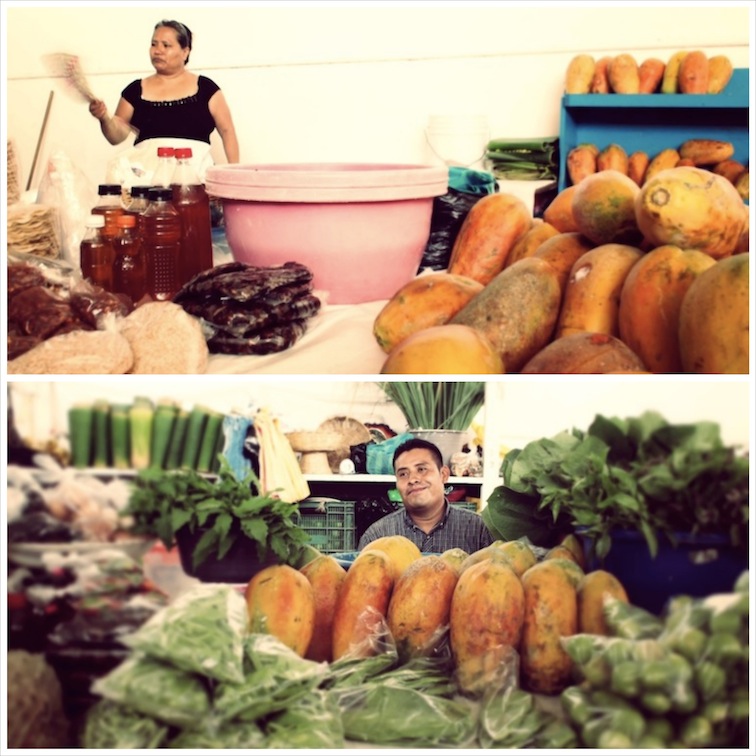
We love papayas and the people who sell them
Mission eventually accomplished, we move to our last destination: Fruteria Reynita. It’s our official stand for general fruit and vegetables, and it has a plethora of articles available at all times. We round up our shopping spree with cucumber, oranges, bananas, mamey, limes and carrots.
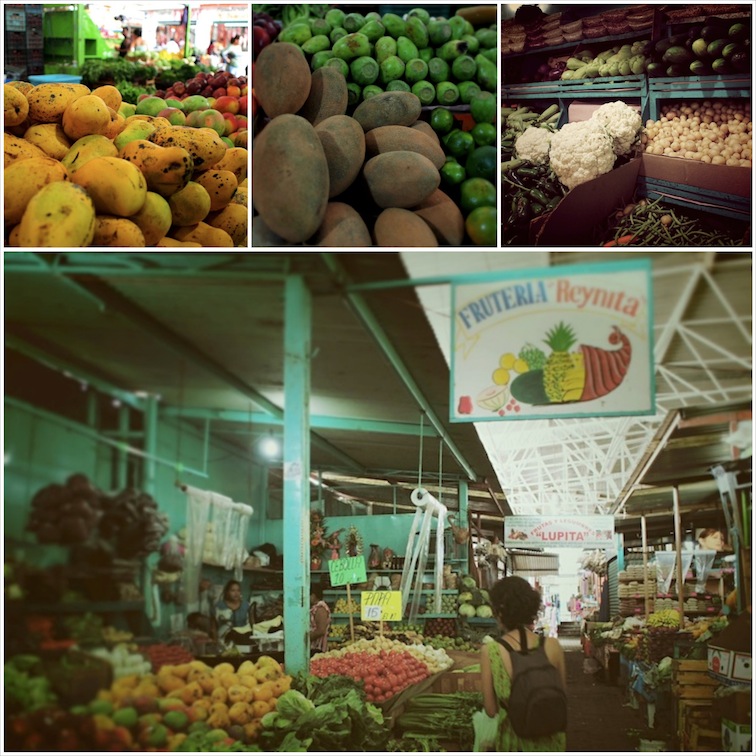
Fruteria Reynita
Funny story: next to the mamey we noticed cactus fruit, still green and therefore not part of our dietary requisites on this particular occasion. Many of the items we now buy on a regular basis were foreign to us prior to our Mexican journey. We had our first taste of mamey in ice-cream form, back in Cholula, eating the actual fruit only afterwards. A similar thing happened when we went for ice-cream at Chepepe, close to the market. One of the flavors at hand was “tuna”, which prompted our salivary glands to recoil in disgust. Noticing our horrified faces, the young lady explained “tuna” was a fruit and not obtainable at sea, “tuna” being Spanish for cactus fruit. Oh. So, in conclusion: you can tune a guitar, but you can’t avoid linguistic embarrassments even if you speak the language. The End. (OK, maybe “funny” is not the right word)
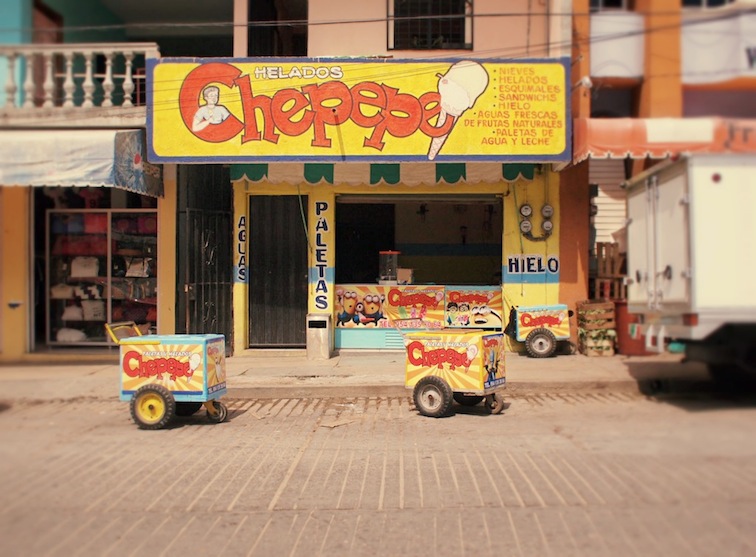
I scream for Chepepe
Our purchases complete, we walk towards one of the many eateries, stomachs already growling. We have had lunch and dinner at a few of the “comedores” (small open restaurants) before, but this time we choose something a little lighter, and sit at Antojitos Eva. The word “antojitos” (literally “little cravings”) is the name for Mexican street food, and normally entails tortas, quesadillas, tamales, tlayudas, tacos, tostadas and other easily prepared snacks. Antojitos Eva is usually bustling with people, but we manage to secure a stool, quickly ordering two quesadillas with flor de calabaza (squash blossom) while eying other options. The quesadillas are done on the spot and are de-li-cious. We also split a “chile relleno” (roasted poblano pepper stuffed with cheese), for good measure. Total cost is 46 MXN (2.7 EUR).
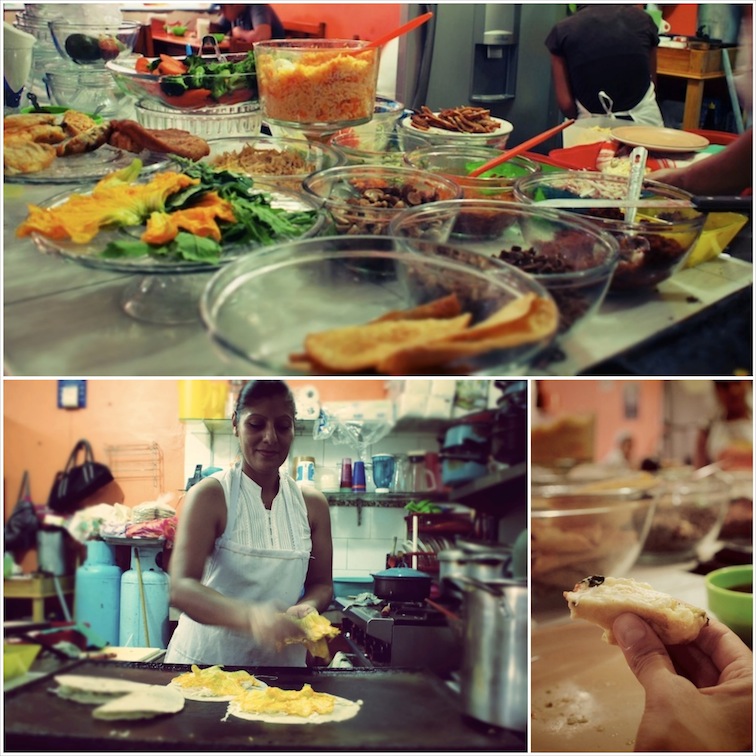
Antojitos Eva. Bottom shows preparation of quesadillas and slice of “chile relleno”
We leave Benito Juárez market with our bounty and hop on a “colectivo”, which drops us at our doorstep 10 minutes later. Since we already have eggs, rice and other more filling sustenance stored away, we are good for the next 4 days. For the sake of an accurate impression, we’ve laid out our newly-purchased groceries on our dinner table. Total cost of all items amounts to 169 MXN (10 EUR).
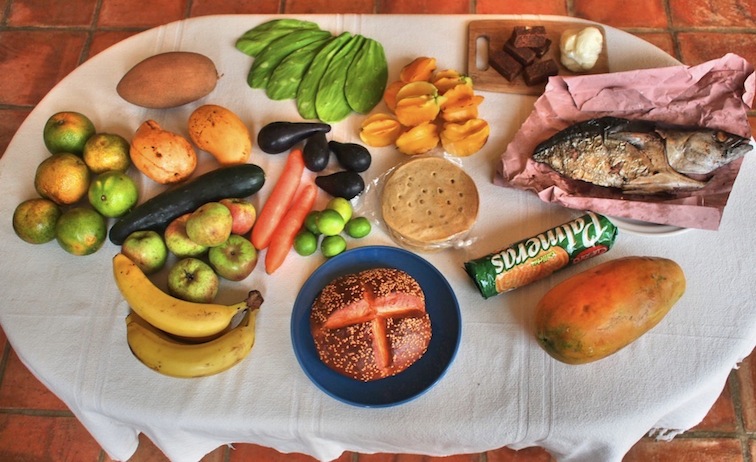
Market bounty, totalling 169 MXN (10 EUR)
To sum up, visiting local markets makes a lot of sense. While being economically advantageous, they also provide an ideal environment for getting a taste of regional culture and traditional products. Furthermore, your hard-earned money will go directly to the pockets of hard-working locals, ensuring it will stay within the confines of the community, instead of in the coffers of some faceless organization. In our book, that’s a win-win situation.

